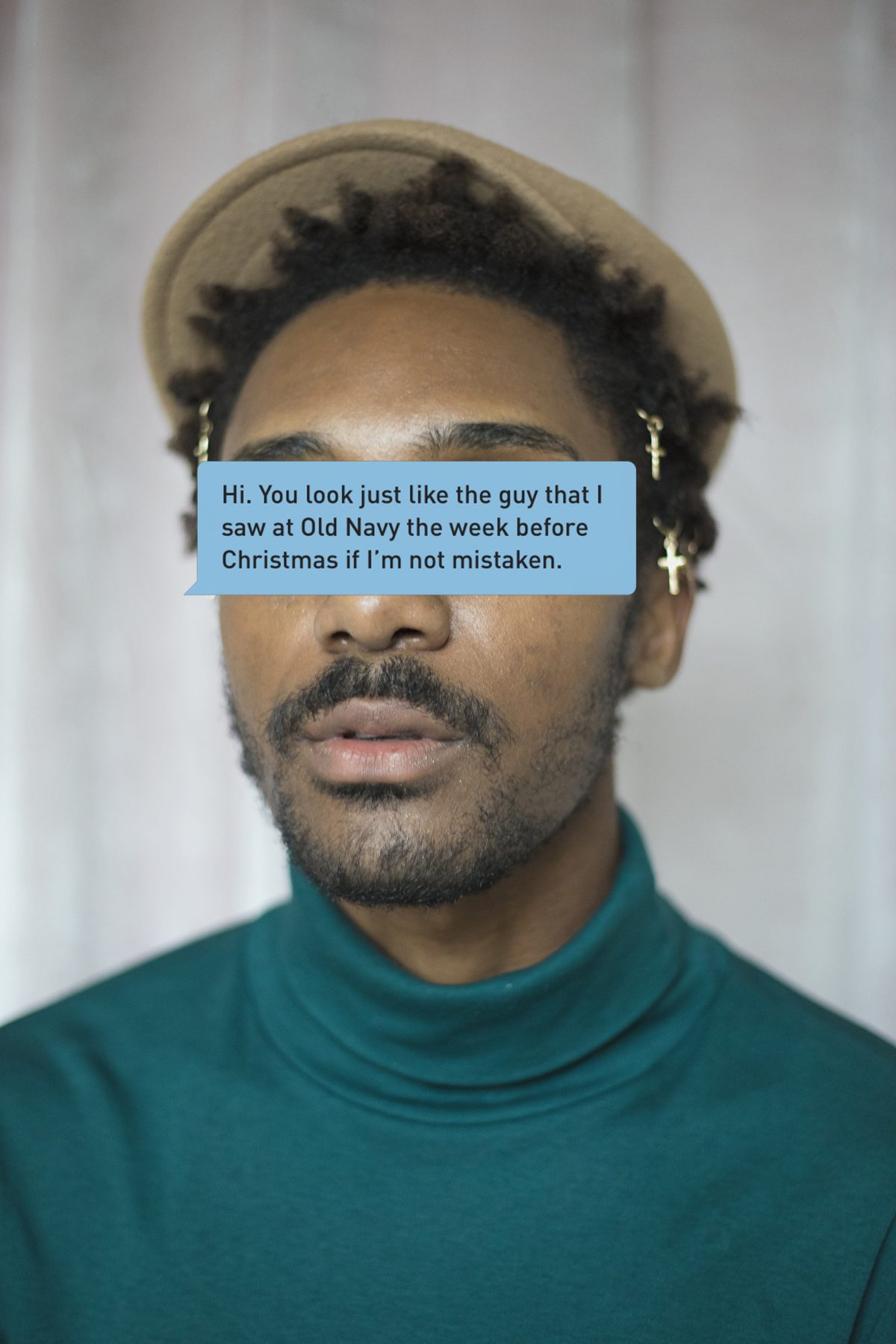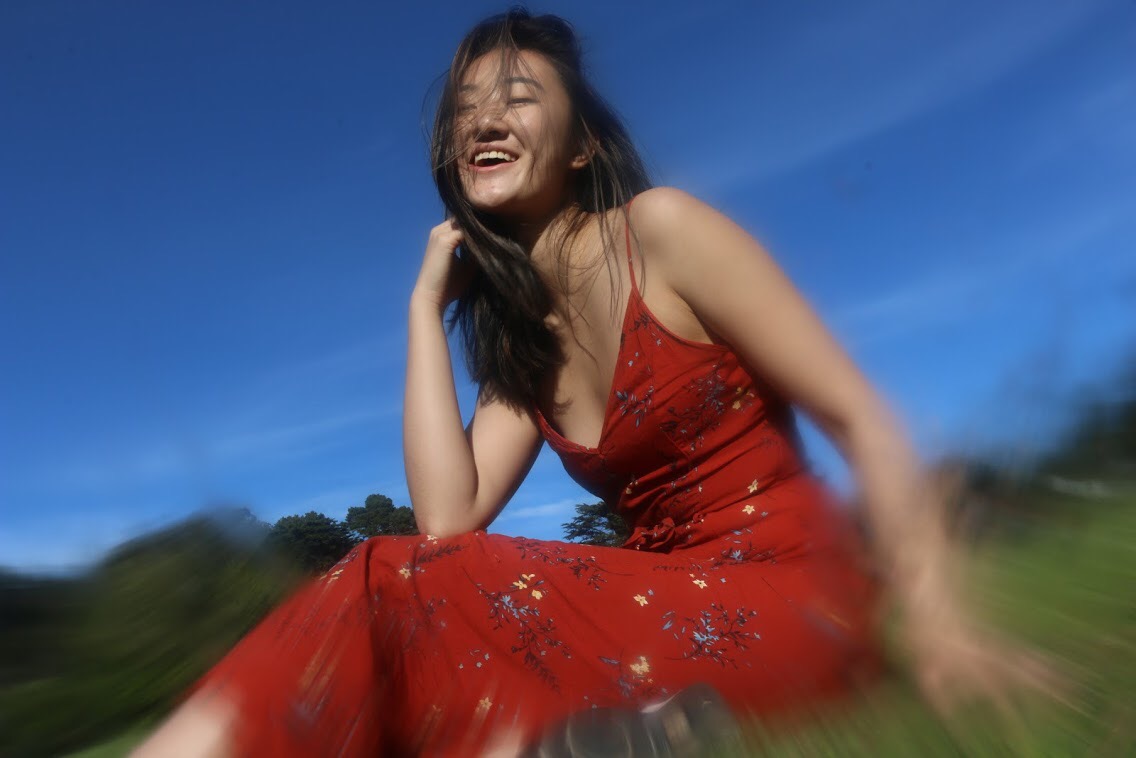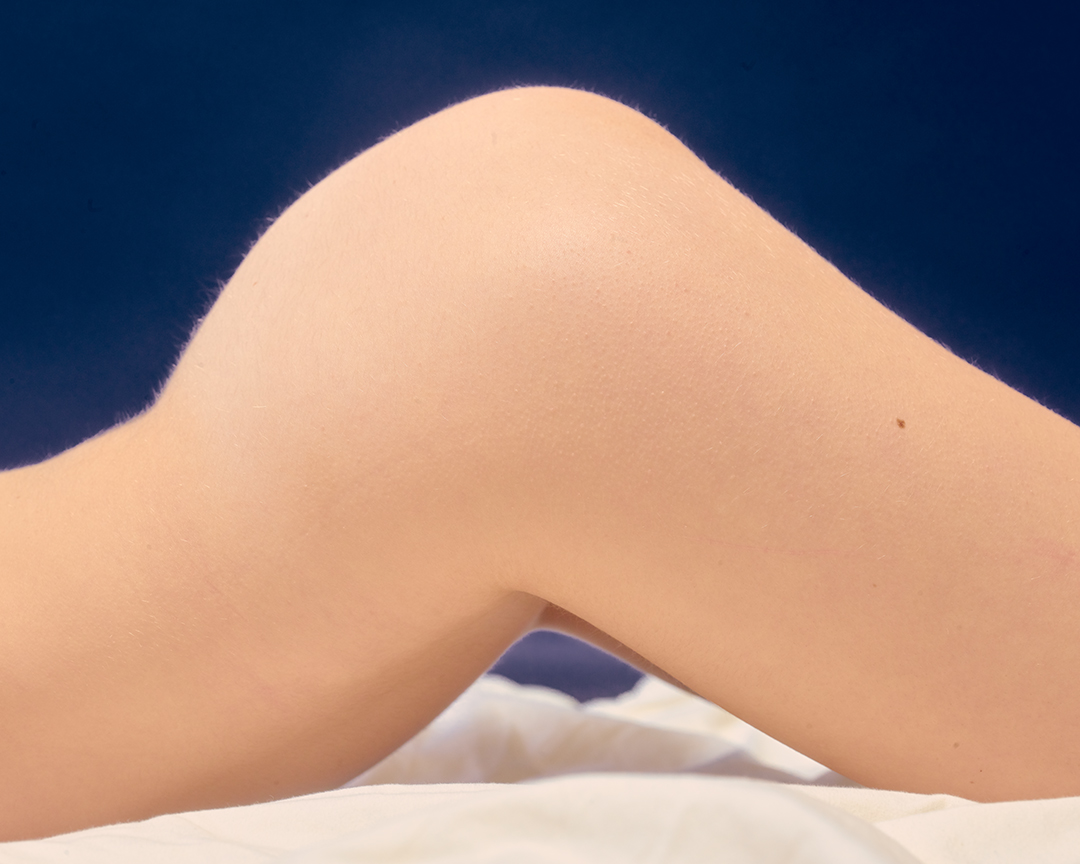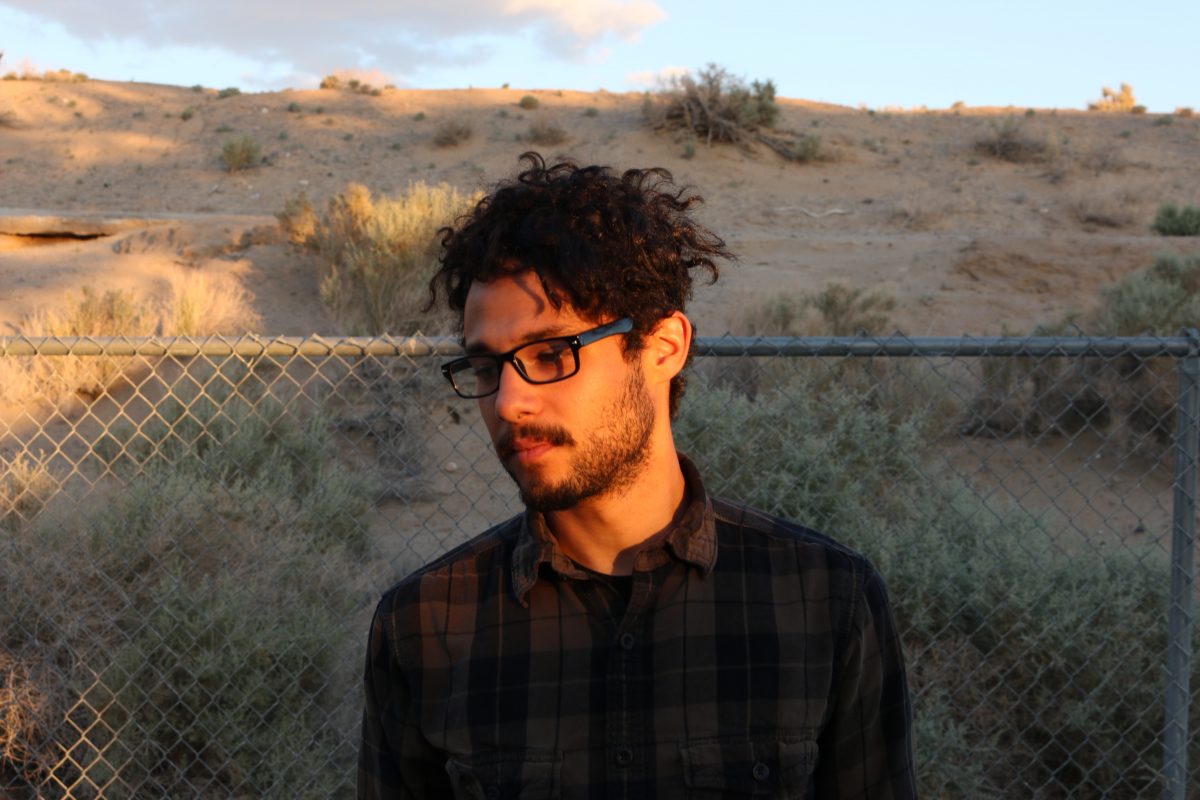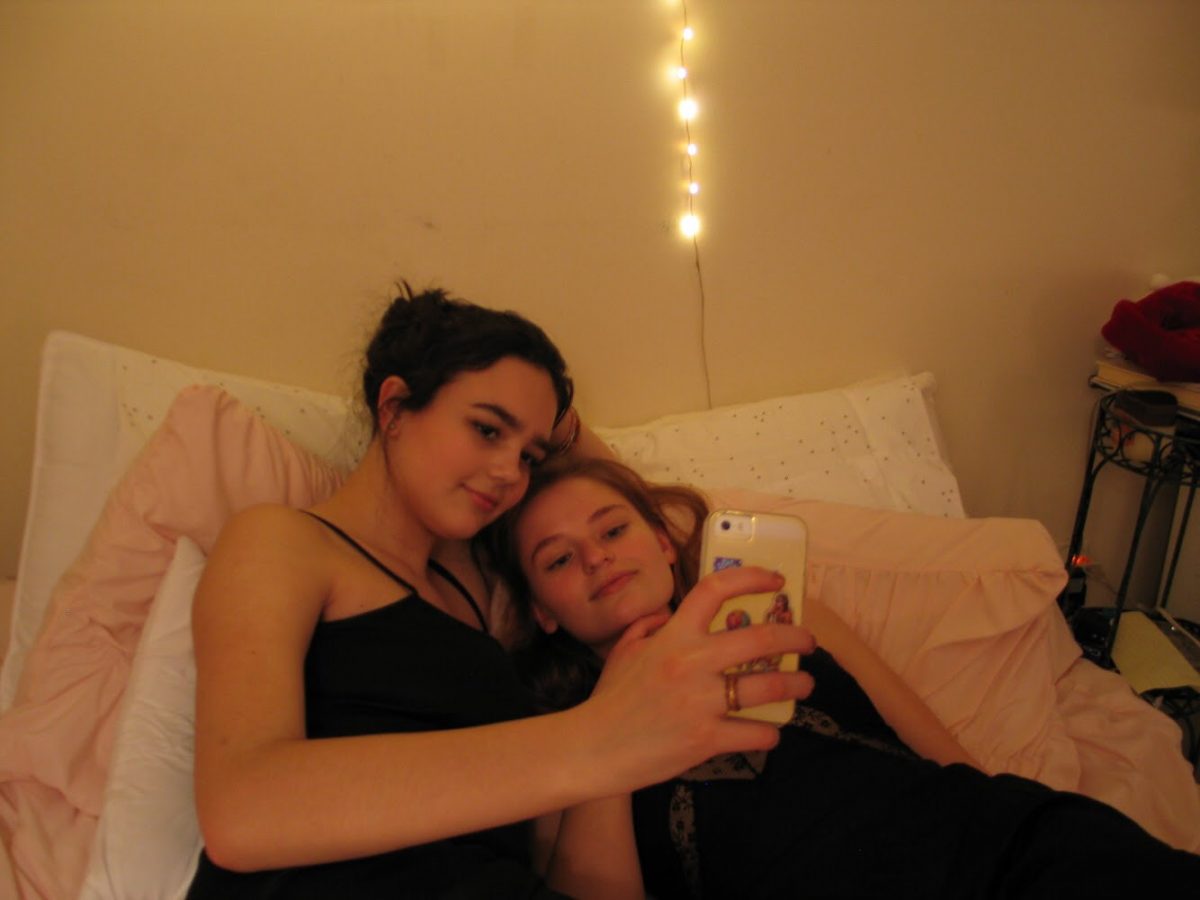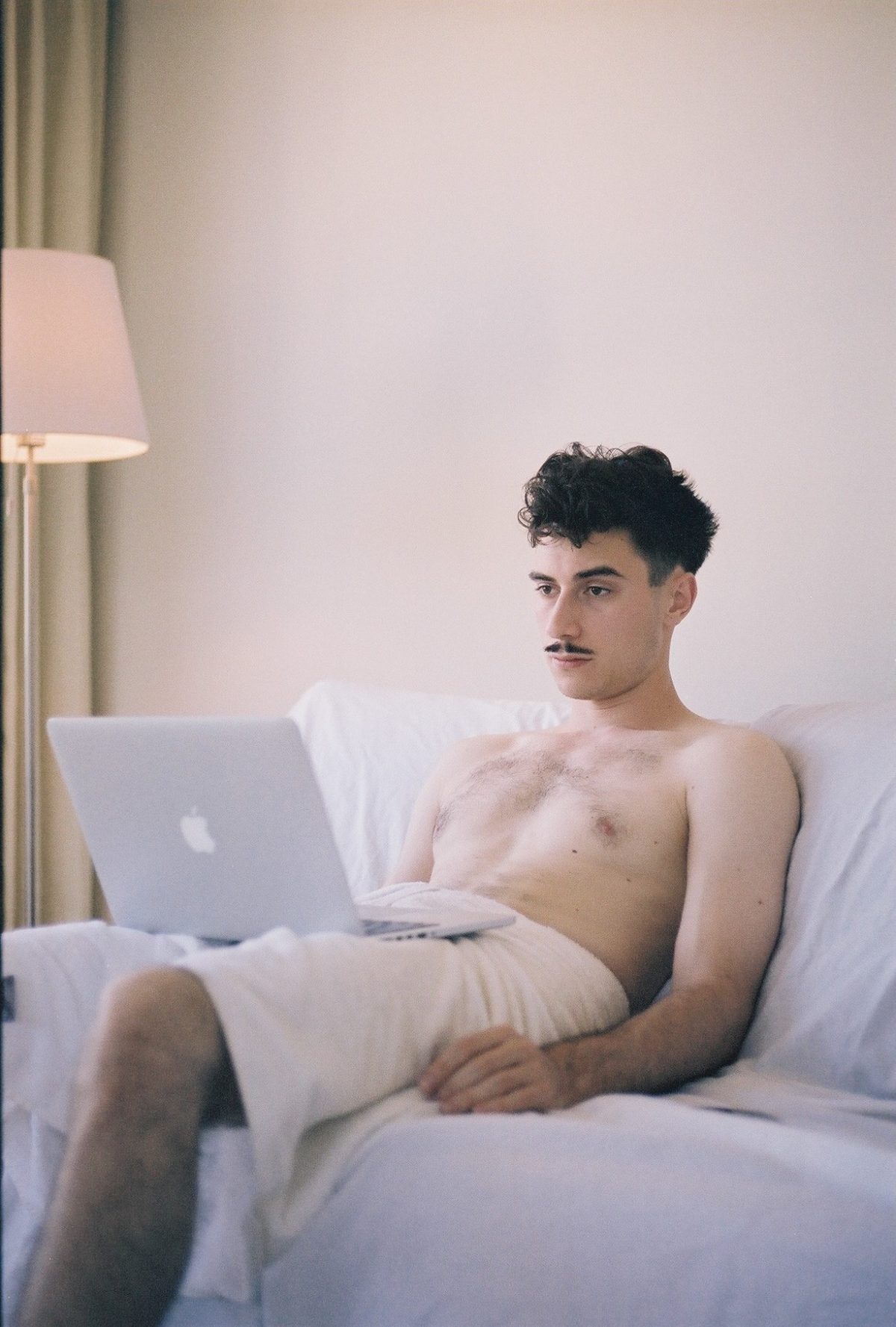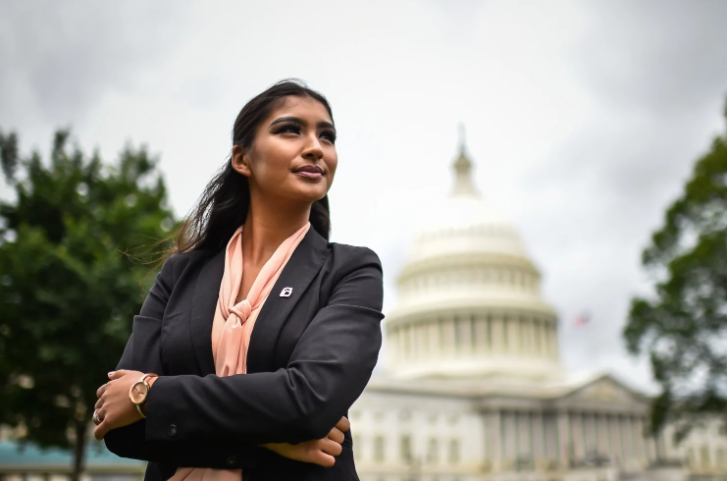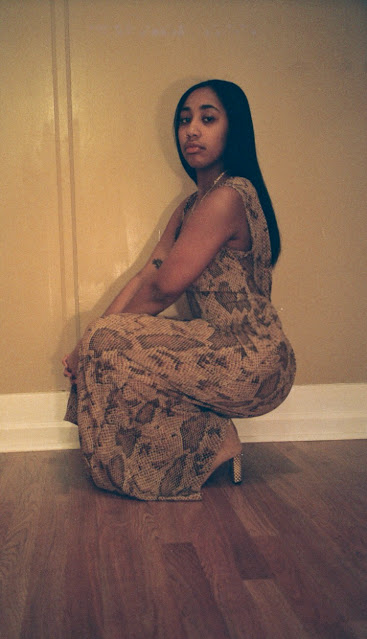DoubleTap is an interview series highlighting creatives whose work explores sex, body, and identity.
Grindr, a modern advent that has, in many ways, picked up where the bathhouses left off, is equal parts sexy, hilarious, and demoralizing. The hookup app is what most cis gay men use to find no-strings-attached sex… and queer photographer and anthropologist-lite Andrew Harper has been watching this space for the sake of art and a nut since he was 18 years old.
If you are unfamiliar with the Grindr interface, it displays “looking” users within a 1-mile radius. The messages between interested parties are often brief and nude-laden. Think OkCupid if OkCupid were a focus group of primed and geographically compatible gays — with triple the dick pics. Since it launched back in 2009, the platform has developed a notoriety for its members’ candor (folks say the darnedest things when they’re horny!). Harper, originally from Florida, takes these exchanges and superimposes them over pictures of himself and his friends. The result of which is the popular Instagram account Gaytona Beach.
It’s a simple enough concept, but by pairing real communications with photos of actual queer bodies, a bit of our reality is laid bare on our feeds. Featuring conversations ranging from sweet affirmations to troubling displays of internalized racism, fatphobia, and femme-shaming — Gaytona is a mirror for the community.
Harper set out to explore the dynamics of gay men negotiating sex, and in the process he is uncovering the cultural and social influences that take us to bed.
What was the initial inspiration for Gaytona Beach?
Harper: When I was living in Daytona Beach, I felt like I was the only openly gay guy around. I had, up until this point, created an identity for myself from all of these things coming of age in coastal Florida, like sneaking margaritas in to-go cups onto the beach, dancing to New Order until we drove our downstairs neighbor into moving out, going on long drives through the swamps at night and turning our headlights off to really see the stars.
But up until 19 [years old], I had never explored the parts of my identity that related to sexuality. You can imagine that when I first downloaded Grindr it was an immediate addiction, because for most of my childhood and early teen years the majority of gay culture came from Tumblr and porn. So I felt that I had virtually nothing but sex, sin, and conflict to attribute to being gay.
I was surprised by how venomous and angry people could be [on] the app, and how easy it seemed for complete strangers to be just as abusive online as [the people who] shouted slurs at me from their pickup trucks. I started documenting the wild conversations I had, and over the course of a few years, compiled a folder of something like 3,000 screenshots (no joke). I was also in school for photography at the time, and so one day I was going through my photos and found one that reminded me of a conversation I had screenshot-ed and bam — the rest is history. I began telling these stories with these conversations and pairing them with real moments of life around me in that city, and it felt humorous and cathartic.
I have to ask, are any of these interactions staged? Are these really all things people have said to you on Grindr?
Believe it or not, they’re 100% real! For the first half of a year or so every message I posted was one [that was] sent to me. Like I mentioned, I had thousands of old conversations and messages to work with. Now I’d say about half of the ones that end up on the page are ones that have been submitted to me. You know how some people get those “Saw this and thought of you!” texts or DMs and it’s like a cute gif of a cat? I get those same messages, but instead it’s a screenshot of a stranger saying “Piss in my ass.” I still pull from that original folder all the time, though.
You’re a photographer and — correct me if I’m wrong — but the majority of the images you use for backdrops are other people’s selfies/nudes. What’s the inspiration behind this?
Yes, the majority lately has been that way, but originally this wasn’t the case — it developed over time with the growth of the project itself. Actually, when KAAST and I first met, I was predominantly still using beach landscapes and photos of spring breakers. Using other people’s selfies started when I first started taking submissions, and it happened kind of naturally because I was already using photos of other people but only ones I had taken. Because I was using images of people with anonymity to convey a story, it only made sense to start incorporating selfies and nudes because that’s the majority of photos being passed along on Grindr.
Would you ever consider taking your own photos to pair with the app exchanges? Or would that undercut the authenticity of what you’re going for?
I love this question because for the people who have been following the page from the beginning or know me IRL, you can actually spot a lot of photos of myself on there. For a while, I was also using a lot of my portrait work — I spent some time in Orlando before moving to New York last year, and I was working for a commercial studio. My mom also owns a studio in a small coastal town called Ormond Beach, so I had a lot of studio work to play with. I wouldn’t say it undercuts the authenticity because the focus of the page is each individual message, and the photos are just a way of bringing them to life and giving them energy or translating them visually for people.
Your posts really run the gambit, hinting at all sorts of queer realities. Are there specific topics you try to tackle with your work?
This changes all the time. Almost weekly, actually.
First I should say I listen carefully to input and criticism. I never expected the project to transform into something that has a sense of responsibility to it, but that’s what’s happened. The topics started as my own personal ones that I encountered — online harassment, drug use in the gay community, the internalized homophobia of others, etc. — these were all things that I was directly exposed to in Daytona Beach. And after documenting those interactions, I decided to express my own perspective.
One time I addressed the local police officers for a homophobic raid they performed (using Grindr!) and tagged them in it. Sometimes [posts are] more lighthearted and humorous, like sugar daddies and small town gossip, but the more interactions I posted for anyone to see, the more responses I got of people being able to relate. Eventually I left Daytona and along with that came a very clear shift in the types of conversations I had and topics that came up (obviously). The bigger the city, the more you see, hear, and experience, and so slowly but surely the page has gravitated towards bigger social conversations. Topics that come up now range anywhere from mental health to body image, and even to things like the response to Hurricane Maria in Puerto Rico. This might be my favorite part about the page, honestly. If you look at it as a timeline, you can visually track the mindset and journey from small town to big city.
How has your approach changed over the years?
As soon as I opened it up to be collaborative, I assumed a sense of responsibility to focus on diversity and inclusiveness. The project used to be just me and my experience — whatever was immediately around me in Daytona Beach. But that’s obviously changed a lot. My surroundings and my community have transformed.
In your professional opinion, what are some of the biggest differences between Grindr in Daytona and Grindr in Brooklyn?
Well, the most obvious difference is the density. Here, the person at the bottom of the list on Grindr is at most like 1,000-2,000 feet away. Back In Daytona, the fourth person over from you could be miles away. Forget about the bottom of the list, they’re usually in the next town over. But to really get an idea of how intensely unique that experience was, you have to take a step back and look at Daytona Beach itself: it proudly wears the locally-crowned title “World’s Most Famous Beach.” It’s the birthplace of NASCAR, a fixture of the American Spring Break phenomenon, and the location of the final showdown between Aileen Wuornos and the law. You can imagine it’s an outlandish group of people down there.
Have individuals whose messages you’ve featured ever gotten salty [that you’ve posted them online] after the fact?
Nope, but I never really expected them to anyways. When I first started [Gaytona Beach] that was what felt the most daring about it — I would get these messages that were sometimes so violent or hateful and [would then] posting them for anyone to see. If you were the person who sent that message, you would A) never want to out yourself for it and B) probably not want to talk to the person that you said it to again. I figured they would never reach out to me via Instagram and reveal any personal information by doing so. Besides, the focus of these posts is the dialogue itself — not the person who said it. My intent was never to create a public roast, but instead to evaluate an experience I was dealing with — which I later learned was a universal experience.
Basically, in order to get salty with me about something you said, you would have to address what it was in the first place. On the other hand, I also don’t post any content that would be harmful to someone or reveal their identity, so that would be the only other time I could see someone being salty with me.
Gaytona Beach definitely deals in the lead up to a hook-up. Would you ever consider exploring the aftermath of it? I could totally see your format applied to themes like ghosting, unrequited crushes, STI scares, etc.
I think you’re on to something here….
Grindr probably has a more artistic connotation for you than most of us. Do you still use the app for pleasure?
Yes! I have this account linked to my profile, but I still mostly just use the app for the same reason anyone does. Eventually I want to [unlink the project’s Instagram account] from there, but for now it generates a lot fun conversations.
What does the future for Gaytona look like?
Bright! Last year I learned a lot, and I’ve made the promise to myself this year to circle back to why it all began in the first place. Growth is fun, change is fun — but its background is what made it interesting. Something else you’ll see more of is an integration between this and my day job [Andrew works in healthcare services].
I’m currently designing a system for people who take (or want to start taking) PrEP to get it them affordably, help with office visits and testing scheduling, as well as answering questions and connecting them with LGBT focused medical providers in the city. I realized there’s a lot I can learn from the diverse following of the page. For instance, if you ask your doctor about the side effects you think you’re having on PrEP, they’ll likely say something like “a small portion of people report experiencing side effects but this will go away soon.” I doubted this for a while, and I recently ran a poll of around 350 Gaytona followers that revealed half of them [have at some point] experienced side effects. Out of that group, around 10% of them experience ongoing side effects from their PrEP.
I’m not completely sure what that will look like for the page, but I’m excited about it. I’d really like to use the page to help New Yorkers connect with affordable LGBT care. Aside from that, I have a couple things I’m crossing my fingers for, but you’ll have to wait to see.
All photos provided by Andrew Harper. You can follow Gaytona Beach here.
